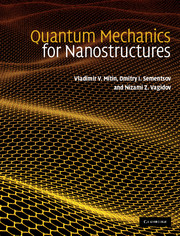Book contents
- Frontmatter
- Contents
- Preface
- List of notation
- 1 The nanoworld and quantum physics
- 2 Wave–particle duality and its manifestation in radiation and particle behavior
- 3 Layered nanostructures as the simplest systems to study electron behavior in a one-dimensional potential
- 4 Additional examples of quantized motion
- 5 Approximate methods of finding quantum states
- 6 Quantum states in atoms and molecules
- 7 Quantization in nanostructures
- 8 Nanostructures and their applications
- Appendix A Classical dynamics of particles and waves
- Appendix B Electromagnetic fields and waves
- Appendix C Crystals as atomic lattices
- Appendix D Tables of units
- Index
Appendix B - Electromagnetic fields and waves
Published online by Cambridge University Press: 05 June 2012
- Frontmatter
- Contents
- Preface
- List of notation
- 1 The nanoworld and quantum physics
- 2 Wave–particle duality and its manifestation in radiation and particle behavior
- 3 Layered nanostructures as the simplest systems to study electron behavior in a one-dimensional potential
- 4 Additional examples of quantized motion
- 5 Approximate methods of finding quantum states
- 6 Quantum states in atoms and molecules
- 7 Quantization in nanostructures
- 8 Nanostructures and their applications
- Appendix A Classical dynamics of particles and waves
- Appendix B Electromagnetic fields and waves
- Appendix C Crystals as atomic lattices
- Appendix D Tables of units
- Index
Summary
In Appendix A, Section A.2, we considered the oscillations of particles using Newton's laws of classical mechanics. The distinctive feature of Newton's mechanics, when considering interactions between particles (for example, the gravitational interaction), is the instantaneous transmission of the interaction between particles, i.e., transmission occurs with infinite speed. The interaction between charged particles is realized through an electromagnetic field, which possesses energy and momentum and is carried through space with finite speed. Electromagnetic waves can exist without any charges in a space in which there is no substance, i.e., in vacuum. This is substantiated by the fact that the equations of classical electrodynamics allow solutions in the form of electromagnetic waves for such conditions.
The main equations of classical electrodynamics are Maxwell's equations, which were formulated after analyzing numerous experimental data. In this sense they are analogous to Newton's equations of classical mechanics. Maxwell's equations are the basis for electrical and radio engineering, television and radiolocation, integrated and fiber optics, and numerous phenomena and processes that take place in materials placed in an electromagnetic field. Together with Newton's equations, Maxwell's equations are the fundamental equations of classical physics. Just like Newton's equations, Maxwell's equations have their limits of applicability. For example, they do not sufficiently well describe the state of an electromagnetic field in a medium at frequencies higher than 1014–1015 Hz.
- Type
- Chapter
- Information
- Quantum Mechanics for Nanostructures , pp. 338 - 377Publisher: Cambridge University PressPrint publication year: 2010



